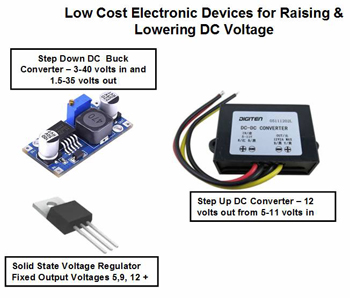Changing voltage up or down
By Phil Lapin / CPPC Technical Coordinator
Thanks mostly to modern electronic technology, we can now get 12 volts out of a 6 volt battery, and we can get completely adjustable lower voltages out of both 6 and 12 volt batteries. This allows for the use of many devices previously difficult to install in vehicles of either 6 or 12 volts. The good news - you don’t have to be an electronics genius to accomplish this.
 First, lets look at raising a battery voltage from 6 volts to 12 volts. This can be accomplished using what is called a “step up converter”. For around $12-15 on Amazon.com, you can purchase a converter which will work with a DC input voltage from 5-11 volts, and will output a constant 12 volts DC and can handle a 2 amp load! There are many of these devices with varying amperage capabilities. Look up “step up converter” on Amazon and also on YouTube to view videos on how these work.
First, lets look at raising a battery voltage from 6 volts to 12 volts. This can be accomplished using what is called a “step up converter”. For around $12-15 on Amazon.com, you can purchase a converter which will work with a DC input voltage from 5-11 volts, and will output a constant 12 volts DC and can handle a 2 amp load! There are many of these devices with varying amperage capabilities. Look up “step up converter” on Amazon and also on YouTube to view videos on how these work.
One thing to be very careful about with any of the devices in this article is to pay attention to polarity. Older vehicles on 6 volt systems normally had a positive ground. If you put any electronics to work, make sure to isolate them from the car body, and hook up the wiring correctly. Positive is positive - whether it is a ground or a hot side. Wire accordingly. Similarly, what you are applying the output voltage to should be isolated from the car body in most cases. Insulation of some type is easily utilized to isolate where necessary.
So, we can easily get from 6 volts to 12 volts - but what about going from 6 or 12 volts to a lower voltage? A very easy way to do this is to use a resistor (of a size capable of handling the current involved). The problem with resistors is that they may not be adequate where the final voltage must remain very steady. If the car battery is discharging - or if it is being charged, the voltage may vary by 2-3 volts. A charged 6 volt battery actually will measure about 6.5 volts. If the generator is charging it, the voltage will increase to 7-8 volts. This can wreak havoc with things like LED lights and cell phone charging.
There are a couple of much better solutions for lowering voltage and keeping the voltage absolutely constant. One of these, which is already to install, is called a “DC to DC Buck Converter”, or a “step down converter”. For $11 on Amazon, you can get a six-pack of these devices! One example of them will take input voltages from 3 volts DC to 40 volts DC. The output can be infinitely adjustable from about 1.5 V DC to 35 V DC. The limitation of the devices is that the input voltage must be 1.5 higher than the output voltage. On a 6 volt car battery, with voltages running from 6.5 V DC up to 7-8V DC, the maximum output voltage would be 5 volts. A simple screw adjustment varies the output voltage.
Another very effective device to control output voltages is a sold state “voltage regulator” These mostly come in fixed output voltages (5,9,12 & other voltages). The simplest type is a small package with three leads. You will have to make up your own “circuit” with these, but it involves only the device and a couple of small capacitors. YouTube has lots of information on these.
On my 1942 Plymouth, I am replacing the “high beam” indicator (bulb) with a small colored LED fitted right up into the top of the dash piece. I am also putting small LEDs into the dash as turn signal indicators. These need a constant voltage of 2-3 volts, so each will have a $2 buck converter powering them. You can create many applications like this on older cars - and take advantage of electronics to properly power them!


